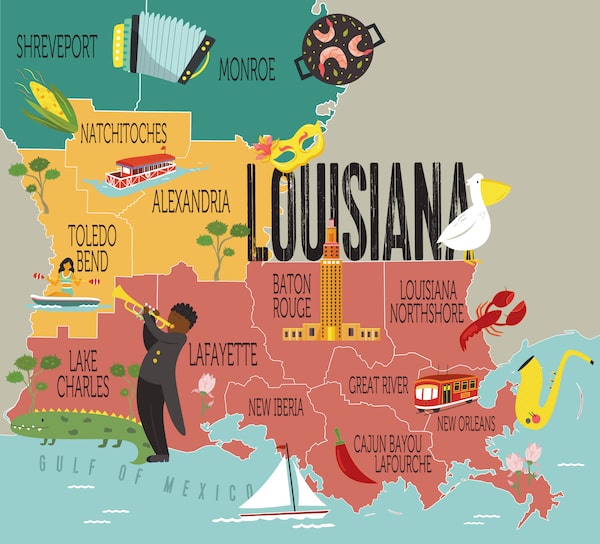
Illustration by Tammy Hoy
Canadians have a passion for the southern U.S. travel spot known as the Bayou State
If only the British knew more than 260 years ago the magical place they would inadvertently be helping create with their Le Grand Dérangement, or Great Expulsion, of Acadian people from Canada’s present-day Maritime provinces. That decision – part of their military campaign against New France – led to a significant number migrating to Spanish Louisiana, where Acadians eventually became Cajuns.
In Louisiana those Acadian roots are celebrated, with locals striving to preserve the authenticity of that culture. Cajuns are part of what Cody Gray, president and chief executive officer of Lafourche Parish’s Cajun Bayou Tourism, calls Louisiana’s “cultural gumbo.”
All across this southern U.S. state, Cajuns blend with Creoles, who are more generally defined as individuals from European, African, Caribbean and Hispanic descent. That creates a cultural richness that helps make Louisiana such a colourful, soulful place to visit.
“It is a mix of ethnicities and people from around the globe, but a major part of that is the Acadians,” Gray says. “That’s what founded this area and life down here as we know it.”
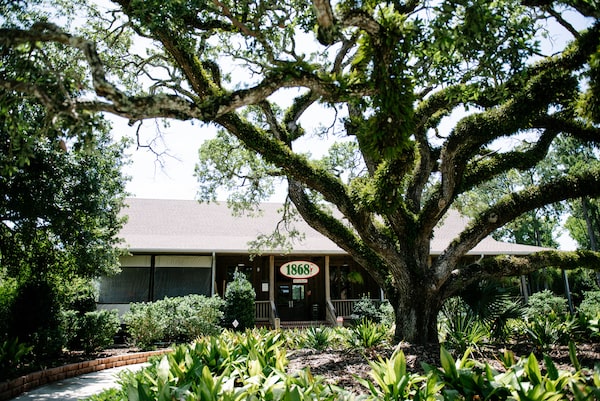
The 1868 Restaurant at the Tabasco factory in Lafayette Parish.Paul Kieu/Supplied
For instance, “marriages between the Acadians, Native Americans, French, Spanish, African and other settlers helped form the many cultures that make up Lafayette Parish,” says Jesse Guidry, vice-president of communications for the Lafayette Convention and Visitors Commission. “Today, tourists flock to Lafayette for a rare taste of the genuine Cajun and Creole experience, from traditional food fixings and music to the warm hospitality that greets you at every turn.”
Across Louisiana, Cajun music features unique styles, from Zydeco, which centres on the accordion and a percussive washboard, to Swamp Pop, a hybrid of rhythm and blues, rock ‘n’ roll and country.
The food is also a highlight for visitors. The region’s cuisine is influenced by its varied culture in dishes such as étouffée, boudin, andouille, maque choux and jambalaya. Fresh seafood such as shrimp, crawfish, crab, catfish and alligator are staples in Louisiana cooking. Creole cuisine is a mix of European, African and Caribbean cooking techniques using Louisiana ingredients prevalent in New Orleans in the early 1800s, while Cajun is a cuisine of the 18th-century Acadian exiles, who settled in the southwest part of the state, in the swamps and on the prairies.
It’s these kinds of offerings that make Louisiana unlike any other destination. And Canadians love it. On average, Louisiana welcomes more than 187,000 Canadians per year to the state – the largest international source market, with the bulk of those travellers coming from Ontario, according to the Louisiana Office of Tourism.
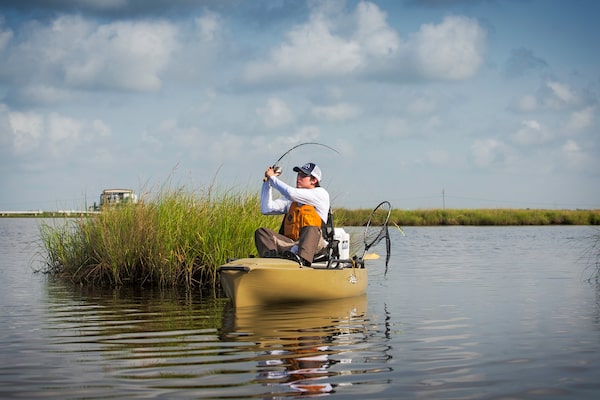
Point-aux-Chenes in Lafourche Parish.Supplied
The ties between parts of Canada and Louisiana were reinforced last summer, when Lafourche Parish announced a tourism partnership with Acadian regions of Nova Scotia, celebrating the similarities between both cultures, especially when it comes to food and music.
Like many other vacation destinations, Louisiana has beautiful sandy beaches on which to soak up the southern sun, but it’s the cultural richness and unique offerings that really set the state apart. The roots of jazz are in New Orleans, so stops at jazz clubs like the historic Preservation Hall and The Spotted Cat Music Club are an absolute must. Mardi Gras is one of the world’s most famous carnivals, a raucous affair of floats and parades, colourful masks and costumes, and is scheduled for Feb. 21 this year. Taking a stroll through the French Quarter of New Orleans or seeing the Old State Capital building in Baton Rouge, a Gothic-Revival-style structure that overlooks the Mississippi River in the city’s downtown, is unforgettable. Memorable tours include vampire-themed ones, including walking tours inspired by New Orleans native Anne Rice’s Interview with a Vampire, and explorations of steamy, alligator-infested swamps.
“What we have seen coming out of COVID-19 is people searching for experiences,” Gray says. “It is those personal connections people want to make, [such as] being able to have that one-on-one talk with your swamp tour operator or that discussion with the restaurant owner at a local Bayou-side restaurant. It’s those connections and experiences that we like to say is the ‘souvenir’ that people take back with them.”
Here’s just a sprinkling of what you can experience in Louisiana.
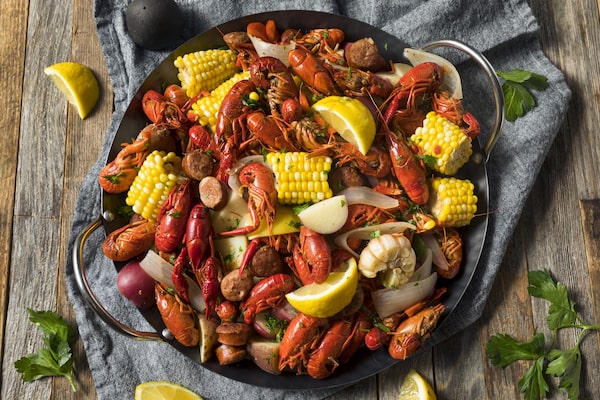
Shreveport-Bossier celebrates crayfish – known as crawfish or mudbugs locally – with Mudbug Madness in May.Dreamstime
Culinary scene
The different ethnicities that make up Louisiana – Native American, French, Spanish, German, English, Caribbean, African and Italian – and form that “cultural gumbo” Gray speaks about all bring their own culinary traditions and techniques to the table. These blend together to create tastes that are specific to this place, with each region boasting its own flavour profile.
In Lafayette, in south-central Louisiana, Cajun Food Tours will take you through the culinary mainstays of Cajun culture while sharing tidbits of history. Tourists love to take a short drive out of the city for the Tabasco factory tour (peppers used for the spicy sauces are grown there), where they can also taste dishes made with the famous hot sauce at Restaurant 1868. Lafayette has received many awards for its cuisine, including being named the Tastiest Town of the South by Southern Living magazine, Best Food Town by Rand McNally and a Top 10 Foodie City by Livability.com.
Culinary delights also abound in Lake Charles, situated right on the border of Texas and 40 minutes from the Gulf of Mexico with brackish and freshwater in between – especially if you love fresh seafood.

Alligator sightings are common in such areas as Lake Charles’ Creole Nature Trail All-American Road.Tim Mueller/Supplied
“This is a modern-day approach to the Cajun and Creole ancestors of the people of Southwest Louisiana who lived off the bounty of the land. It’s almost impossible to separate culinary traditions that have been simmering in kitchens for centuries from the land: the marshland, gulf waters and abundance of prairie land,” says Angie Manning, vice-president of communications for Visit Lake Charles. “The rich traditions of culinary arts in southwest Louisiana are tied to our Cajun and Creole heritage, and the blending of cultures that creates unique dishes that can only be found in this part of the country. Even throughout Louisiana, gumbos taste different, depending on the recipes that have been passed down.”
Some of the celebrated chefs and food experiences of the area include the 2022 reigning Queen of Louisiana Seafood, Amanda Cusey, executive chef of Villa Harlequin, as well as of The Terrace, opening this year. Luna Bar & Grill, owned by chef Dave Evans, was voted one of the most popular restaurants in southwest Louisiana. Mama Reta’s Kitchen is where everyone goes for southern comfort food.
In the historic city of Covington in St. Tammany Parish, just over an hour’s drive east of Baton Rouge, two culinary stand-out husband and wife teams cook and serve in restaurants within a few blocks of each other. Guests can sample house-made delights from chefs David and Torre Solazzo at airy Del Porto Ristorante and at The Greyhound gastropub; while LOLA chefs Keith and Nealy Frentz make magic out of simple Southern food in an old rail depot where a caboose was converted into a kitchen.
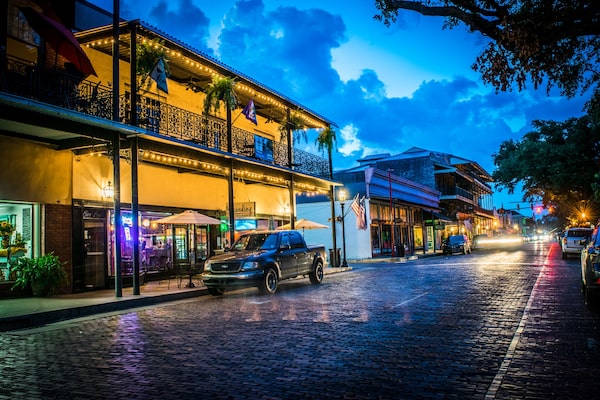
Historic Front Street in Natchitoches offers walking tours along its cobblestone streets.Dreamstime
History and culture
One of the defining features of Natchitoches (Nack-a-tish), located in north-central Louisiana and established in 1714 (the oldest settlement in the Louisiana Purchase), is its European flavour through its architecture, heritage and lifestyle, says Ashley Paz, director of sales and marketing, Natchitoches Convention & Visitors Bureau.
Walking tours along cobblestone streets up and down the historic district of Front Street, where many buildings dating back to the city’s origins still stand, draw people here. That includes a stop at the old Kaffie-Frederick General Mercantile store, which opened in 1863 and is the oldest business in the city. Creole plantation tours are particularly popular.
“It’s a small town, with so much history and culture; everyone is so friendly, and there’s always something on the go,” Paz says.
St. Tammany Parish is just 45 minutes from New Orleans’ French Quarter, a mecca for tourists in large part because of its 80,000 acres of green spaces and waterways. New Orleanians have considered the Louisiana Northshore a getaway since the 1880s, when steamboats brought them across Lake Pontchartrain to stay in resorts where the deep-spring water was reputed to cure ills and calm nerves.
The area’s cultural scene, culinary treasures and picturesque towns draw legions of tourists. Music venues such as the Dew Drop Jazz & Social Hall (the oldest unaltered jazz hall in the world) and the Abita Opry are must-sees for those seeking authentic experiences.
In Baton Rouge, museums such as Capitol Park Museum, LSU Rural Life Museum and the USS KIDD Veterans Museum are popular destinations. “With over 300 years of history, it’s no secret that Baton Rouge has a story to tell,” says Gina Stephens, content marketing manager with Visit Baton Rouge.
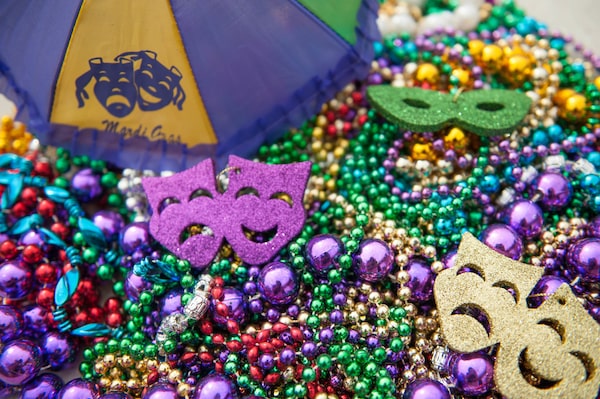
Mardi Gras is celebrated across the state, including in St. Tammany Parish.Supplied
Festivals and events
Festivals in Louisiana celebrate food, art and culture – and there are so many to enjoy.
Mardi Gras, the pre-Lent Carnival event for which New Orleans is arguably most famous, is actually celebrated throughout the entire state with scores of street and boat parades.
In St. Tammany Parish, other festivals include the Great Louisiana BirdFest, the Louisiana Bicycle Festival, Three Rivers Arts Festival, Madisonville’s Wooden Boat Festival, Bluesberry Festival, the Abita Springs Whole Town Garage Sale and the Crab Festival. There are also crawfish cook-offs, art walks, antiques fairs, free concerts and an annual parish fair.
“Everything is cause for a party on the Northshore,” says Erica Glory, marketing representative at Louisiana Northshore St. Tammany Parish.
In Shreveport-Bossier, in northwestern Louisiana, Mudbug Madness in May celebrates crayfish – called “crawfish” or “mudbugs” locally – boiled up with corn and potatoes. Louisiana SoulFood Fall Festival in August is a three-day affair celebrating southern cuisine, art and live music, and Red River Revel is a nine-day festival in early fall celebrating art, local food, music and children’s experiences.
Shreveport-Bossier is also home to the mighty Red River and features many breathtaking bayous and lakes.
“We’re a little bit of this, and a little bit of that,” says Katharyn DeVille, vice-president of marketing and communications with Shreveport-Bossier Convention and Tourist Bureau. “And that’s what makes us unique.”
DeVille says Holidays on the Red is a particular delight for families during the holiday season, featuring fireworks, a giant garden park filled with lights, a magical aquarium experience, and even snowfall in a science museum.
The Lafayette region is also teeming with celebratory events year-round, led by one of the largest outdoor francophone festival anywhere, Festival International, in the spring. In October, Festivals Acadiens et Créoles is a free festival over three days with nonstop music, dancing and culture that’s billed as a “genuine Cajun and Creole experience.”
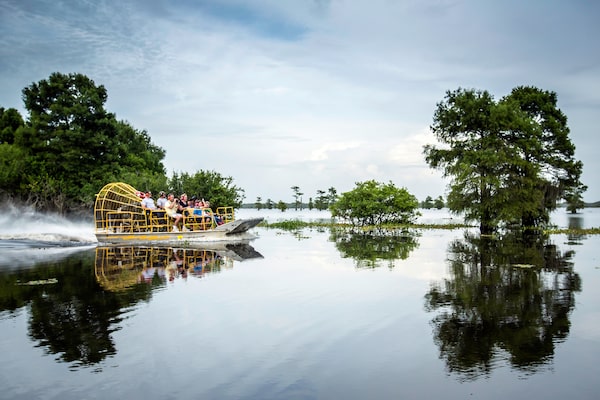
McGee’s Swamp Tours in the Atchafalaya Basin in the heart of Cajun Country west of Baton Rouge.Supplied
The state’s capital, Baton Rouge, hosts one of the fastest-growing festivals in the country in the spring – the Baton Rouge Blues Festival. Thousands of visitors come together for a weekend of live blues music and food in the city’s downtown.
At the beginning of January and after the holidays, the city gears up for Carnival season as visitors and locals flock to the area for its Spanish Town Parade, in which revellers don pink attire in honour of Baton Rouge’s oldest neighbourhood of Spanish Town, whose mascot is the pink flamingo.
It’s the unique tastes, sounds and sights such as these that make Louisiana such a memorable place to visit, and why so many Canadians choose every year to make the trek south to the Bayou State.
Advertising feature produced by Globe Content Studio and the Louisiana Travel Association. The Globe’s editorial department was not involved.